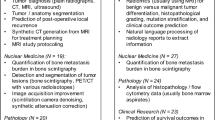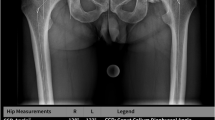Abstract
Artificial intelligence (AI) represents a broad category of algorithms for which deep learning is currently the most impactful. When electing to begin the process of building an adequate fundamental knowledge base allowing them to decipher machine learning research and algorithms, clinical musculoskeletal radiologists currently have few options to turn to. In this article, we provide an introduction to the vital terminology to understand, how to make sense of data splits and regularization, an introduction to the statistical analyses used in AI research, a primer on what deep learning can or cannot do, and a brief overview of clinical integration methods. Our goal is to improve the readers’ understanding of this field.




Similar content being viewed by others
References
Rosenblatt F. The perceptron: a probabilistic model for information storage and organization in the brain. Psychol Rev. 1958;65(6):386–408.
Hubel DH, Wiesel TN. Effects of monocular deprivation in kittens. Naunyn Schmiedebergs Arch Exp Pathol Pharmakol. 1964;248:492–7.
Yosinski J, Clune J, Nguyen A, Fuchs T, Lipson H. Understanding neural networks Through deep visualization. ar**v [csCV]. Published online June 22, 2015. http://arxiv.org/abs/1506.06579
Lee H, Grosse R, Ranganath R, Ng AY. Convolutional deep belief networks for scalable unsupervised learning of hierarchical representations. In: Proceedings of the 26th Annual International Conference on Machine Learning. ICML ’09. Association for Computing Machinery; 2009:609–616.
Mutasa S, Sun S, Ha R. Understanding artificial intelligence based radiology studies: what is overfitting? Clin Imaging. 2020;65:96–9.
Deng J, Dong W, Socher R, Li L-J, Li K, Fei-Fei L. ImageNet: a large-scale hierarchical image database. In: 2009 IEEE Conference on Computer Vision and Pattern Recognition 2009;248–255.
Barbedo JGA. Impact of dataset size and variety on the effectiveness of deep learning and transfer learning for plant disease classification. Comput Electron Agric. 2018;153:46–53.
Powers DMW. Evaluation: from precision, recall and F-measure to ROC, informedness, markedness and correlation. ar**v [csLG]. Published online October 11, 2020. http://arxiv.org/abs/2010.16061
Fawcett T. An introduction to ROC analysis. Pattern Recogn Lett. 2006;27(8):861–74. https://doi.org/10.1016/j.patrec.2005.10.010.
Ren M, Yi PH. Deep learning detection of subtle fractures using staged algorithms to mimic radiologist search pattern. Skeletal Radiol. Published online February 12, 2021. https://doi.org/10.1007/s00256-021-03739-2
Chartrand G, Cheng PM, Vorontsov E, et al. Deep learning: a primer for radiologists. Radiographics. 2017;37(7):2113–31.
Mariano VY, Min J, Park J-H, et al. Performance evaluation of object detection algorithms. Object recognition supported by user interaction for service robots. https://doi.org/10.1109/icpr.2002.1048198
Zhang YJ. A survey on evaluation methods for image segmentation. Pattern Recognit. 1996;29(8):1335–46.
Zech JR, Badgeley MA, Liu M, Costa AB, Titano JJ, Oermann EK. Variable generalization performance of a deep learning model to detect pneumonia in chest radiographs: a cross-sectional study. PLoS Med. 2018;15(11):e1002683.
Zech J. RSNA 2017: Be skeptical of implausible claims about deep learning. Medium. Published November 30, 2017. Accessed March 15, 2021. https://jrzech.medium.com/rsna-2017-be-skeptical-of-implausible-claims-about-deep-learning-9c7a9beeb0e1
Esteva A, Kuprel B, Novoa RA, et al. Corrigendum: dermatologist-level classification of skin cancer with deep neural networks. Nature. 2017;546(7660):686.
Lee H, Tajmir S, Lee J, et al. Fully automated deep learning system for bone age assessment. J Digit Imaging. 2017;30(4):427–41.
Halabi SS, Prevedello LM, Kalpathy-Cramer J, et al. The RSNA pediatric bone age machine learning challenge. Radiology. 2019;290(2):498–503.
Feng R, Badgeley M, Mocco J, Oermann EK. Deep learning guided stroke management: a review of clinical applications. Journal of NeuroInterventional Surgery. 2018;10(4):358–62. https://doi.org/10.1136/neurintsurg-2017-013355.
Zheng Q, Shellikeri S, Huang H, Hwang M, Sze RW. Deep learning measurement of leg length discrepancy in children based on radiographs. Radiology. 2020;296(1):152–8.
Mutasa S, Chang PD, Ruzal-Shapiro C, Ayyala R. MABAL: a novel deep-learning architecture for machine-assisted bone age labeling. J Digit Imaging. 2018;31(4):513–9.
Lee JH, Kim KG. Applying deep learning in medical images: the case of bone age estimation. Healthc Inform Res. 2018;24(1):86–92.
Buda M, Wildman-Tobriner B, Hoang JK, et al. Management of thyroid nodules seen on US images: deep learning may match performance of radiologists. Radiology. 2019;292(3):695–701.
Samek W, Wiegand T, Müller K-R. Explainable artificial intelligence: understanding, visualizing and interpreting deep learning models. ar**v [csAI]. Published online August 28, 2017. http://arxiv.org/abs/1708.08296
Castelvecchi D. Can we open the black box of AI? Nature News. 2016;538(7623):20.
Gilpin LH, Bau D, Yuan BZ, Bajwa A, Specter M, Kagal L. Explaining explanations: an overview of interpretability of machine learning. In: 2018 IEEE 5th International Conference on Data Science and Advanced Analytics (DSAA). ieeexplore.ieee.org; 2018:80–89.
Reyes M, Meier R, Pereira S, et al. On the interpretability of artificial intelligence in radiology: challenges and opportunities. Radiol Artif Intell. 2020;2(3):e190043.
Wu C, Gales MJF, Ragni A, Karanasou P, Sim KC. Improving interpretability and regularization in deep learning. IEEE/ACM Trans Audio Speech Language Process. 2018;26(2):256–65.
lukeoakdenrayner. Ten controversial opinions about medical AI. Published May 4, 2019. Accessed March 4, 2021. https://lukeoakdenrayner.wordpress.com/2019/05/04/ten-controversial-opinions-about-medical-ai/
Harvey HB, Gowda V. How the FDA regulates AI. Acad Radiol. 2020;27(1):58–61.
Benjamens S, Dhunnoo P, Meskó B. The state of artificial intelligence-based FDA-approved medical devices and algorithms: an online database. NPJ Digit Med. 2020;3:118.
Allen B. The role of the FDA in ensuring the safety and efficacy of artificial intelligence software and devices. J Am Coll Radiol. 2019;16(2):208–10.
Tang A, Tam R, Cadrin-Chênevert A, et al. Canadian Association of Radiologists White Paper on Artificial Intelligence in Radiology. Can Assoc Radiol J. 2018;69(2):120–35.
Liang W, Yao J, Chen A, et al. Early triage of critically ill COVID-19 patients using deep learning. Nat Commun. 2020;11(1):3543.
Zbontar J, Knoll F, Sriram A, et al. fastMRI: an open dataset and benchmarks for accelerated MRI. ar**v [csCV]. Published online November 21, 2018. http://arxiv.org/abs/1811.08839
Yala A, Schuster T, Miles R, Barzilay R, Lehman C. A Deep learning model to triage screening mammograms: a simulation study. Radiology. 2019;293(1):38–46.
Author information
Authors and Affiliations
Corresponding author
Ethics declarations
Conflict of interest
The authors declare no competing interests.
Additional information
Publisher's note
Springer Nature remains neutral with regard to jurisdictional claims in published maps and institutional affiliations.
Rights and permissions
About this article
Cite this article
Mutasa, S., Yi, P.H. Deciphering musculoskeletal artificial intelligence for clinical applications: how do I get started?. Skeletal Radiol 51, 271–278 (2022). https://doi.org/10.1007/s00256-021-03850-4
Received:
Revised:
Accepted:
Published:
Issue Date:
DOI: https://doi.org/10.1007/s00256-021-03850-4




